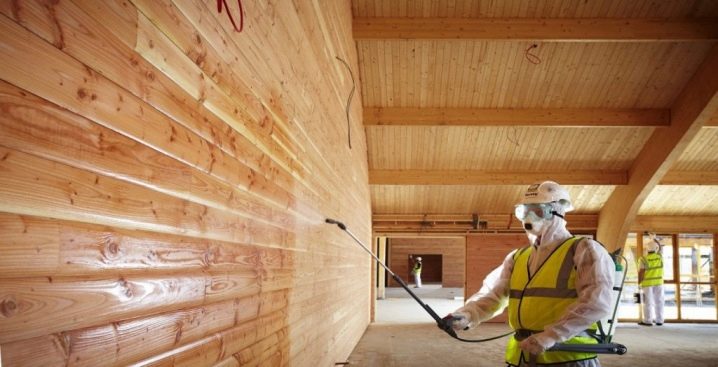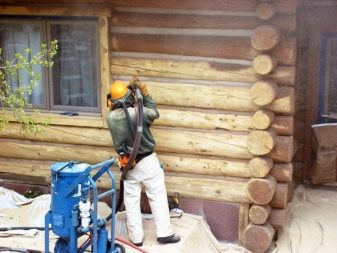How to choose a primer for wood for painting?
Natural wood is one of the most common materials in the field of decoration and decoration. Despite its many advantages, the array is a vulnerable raw material that needs special treatment and care. Developed many tools designed to improve the practicality and life of the tree. High-quality primer for wood will help to cope with various problems that can be encountered when working with material. The article will learn about the selection of primer for wood for painting with acrylic paints.
Purpose of the composition
Before priming a wooden surface, you need to identify the objectives of this treatment agent.
Disinfection
Many types of wood are subject to putrefactive processes. As a rule, such a deficiency is present in available wood species. Rotting spoils the appearance of the product and shortens its service life. This process arises from the contact of the surface with water. Humid environment is an ideal breeding ground for bacteria. To prevent this process, an antiseptic is added to the primer. The component preserves the beauty of natural material for many years.
Reliability
The structure strengthens the top layer of wood. This property is especially important when working with old wood. After processing, the service life of products made of natural materials increases by several times, whether they are structures (stairs, furniture, decorative elements), horizontal or vertical surfaces (floor, walls). The resins in the composition of the solution penetrate deep into the fibers and securely fasten them together.
Reduced absorption
Wood has absorbent properties that depend on the variety. If you apply the enamel on the surface of the material without prior treatment with a primer, a large amount of paint will be absorbed into the pores. As a result, most of the money will be wasted.Micropores are covered with a primer, which creates a smooth and even surface for flawless application of paint and varnish products.
Protection
The strong protective film appearing on a tree increases a practicality of the basis and its service life. Products made of natural wood cost a lot, it is recommended to take care of their additional processing and protection. The primer will protect the array from corrosion, excess moisture, mold and other troubles.
Aesthetic appearance
In the tree there is tannin (natural dye). Over time, the component begins to emerge from the fibers to the surface; therefore, spots appear on the tree, spoiling the appearance of the surface. Priming will overlap the pores and seal this component inside.
Texture
The primer will change the surface, make it textured and rough. Such changes have a positive effect on the adhesive properties of the material.
Colour
Pre-treatment of the primer allows you to fully reveal the beauty and richness of the paint. If you apply the enamel directly to the tree, the final result can be very different from the desired one.Experts use a white primer to reveal the shade.
Types of formulations
The modern market offers a huge range of primer designed specifically for working with wood. To make the right choice, you need to familiarize yourself with various solutions, their features and objectives. According to functional aspects, the specialists divided the compositions into groups.
Antiseptics
Their main task is to protect natural raw materials from harmful microorganisms. This composition is perfect to protect the coating from the appearance of bacteria, the removal of existing microorganisms that spoil the wood.
Fortification
To make the material more reliable, dense and durable, use such compounds. On the shelves of stores you can find them under the names "primers" or "deep penetration primer." This treatment will increase the resistance to the vagaries of weather.
Moisture protection
Hydrophobic primers will prevent excessive moisture from the material. The product is used in the processing of facades. The solution is ideal for work in buildings on the territory of which there is an increased rate of humidity.
Primer composition
The composition of the treatment solutions have their own classification.
Acrylic Primer
Acrylic penetrating primer is excellent for paints and varnishes of any type. This product is almost completely absorbed into the wood after application.
It has certain advantages:
- This primer has no unpleasant smell, due to which it is comfortable to work with the material.
- It takes several hours to dry (1-4). The time spent on processing is significantly reduced.
- Dilute the composition with cool water.
- This primer is actively used in interior decoration.
Silicone-acrylic primer
Products of this type differ from the others in high hydrophobic properties. Pay attention to the composition, if you plan to carry out work in a wet environment. The treated surface (regardless of the moisture in the environment) will demonstrate a stable level of humidity.
Alkyd
These products are used together with alkyd paints and varnishes. The composition of these solutions are very similar. For painted surfaces it is recommended to choose an alkyd primer.On sale you will find special pigmented alkyd types of mixtures that form a matte surface. For complete drying will have to wait 12 - 18 hours.
Polyvinyl acetate
Polyvinyl acetate groups have a distinctive advantage - fast drying. The minimum time is half an hour. To improve the adhesion of the wood after the primer has dried on the surface, it is necessary to walk with ordinary PVA glue.
Polyurethane
This primer is more expensive than other compounds. It is used together in the paint products, which include polyurethane resins. Polyurethane primers differ from the same enamels and varnishes by the percentage ratio of solvent and the absence of tinting components.
Shellac
This type of primer is used to smooth wooden surfaces. It is an effective agent for arresting holes from which resins flow. The compositions are used in the form of an insulating element in soluble stains.
Main selection criteria
In order to choose the right primer, it is necessary to take into account several criteria.
Place of work
Before you buy a primer, you need to know for sure whether the product is purchased for interior or exterior use. Some formulations are designed specifically for work on the street, others are recommended for indoor use. Properly chosen means - a pledge of quality results.
Microclimate
Primers are commercially available that are resistant to various external influences (dry and hot air, humidity, temperature changes). Be sure to consider these properties when choosing a product. The maximum hydrophobic effect allows the use of a primer in areas with a high rate of moisture.
Drying time
This parameter should be considered when choosing a treatment tool. In the hot season it is recommended to carry out the priming procedure in the morning or in the daytime. Drying time is significantly reduced if you work outdoors. Alkyd primer dries especially quickly, it must be applied in several layers.
Material for further processing
Depending on what you put on a primed surface (varnish or paint), you should choose the type of composition.If you want to demonstrate the natural shade of natural wood, make a choice in favor of transparent compositions in tandem with varnishes. A white primer will reveal the fullness and richness of the paint. On a white background color looks much more expressive.
Expert advice
Do not save on primers. On their quality depends on the appearance of the surface, resistance to various external and internal factors. If your budget is limited, it is better to spend less on enamel or varnish. Be sure to read the instructions to the composition, especially if you use the primer for the first time and carry out the work without the participation of a specialist. Purchase products from trusted outlets. If necessary, require the presence of appropriate certificates. If you buy a product remotely (for example, through a website), carefully read the description of the product, read its composition.
Basics of wood preparation
The final result depends on the quality of the primer and surface preparation. Carefully clean the tree of dust particles and other contaminants. Sand the surface if necessary. Primer can be on the old paint, if the type of enamel and color match.
In this case, completely remove the old paint is not necessary. Otherwise, the old particles are removed with a conventional spatula. If necessary, use a solvent. Grind the surface. If you are dealing with a fresh tree, you should chisel and grind the surface. If there are minor flaws on the canvas, they are covered with acrylic putty.
For information on how to select and process wood, see the following video.


















































